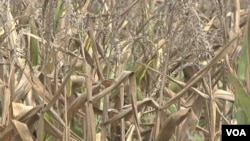Global food prices were unchanged in the August U.N. index, following a sharp rise in the previous month.
A summer of drought in the United States and the Russian Federation has reduced anticipated global corn and wheat supplies. The U.N. Food and Agriculture Organization’s index of globally-traded food commodities rose six percent in July as a result.
Worst is over
But the worst appears to be over, says FAO economist Concepcion Calpe. “We’re not in a bad situation, or as bad situation as we were last month because the prospects are not worsening further. And that is already good news.”
It is also relatively good news that the index remains about 10 percent below its February 2011 peak, Calpe says, but food prices are still double what they were a decade ago.
“They’re high; they are not low," Calpe says. "But they are not as high as they were last year.”
Market volatility
Demand remains high for food commodities. The United Nations estimates that more cereal crops will be consumed this year than will be produced, which means markets will dip into reserve supplies.
But Calpe cautions that those reserves have been low for several years. “And therefore we are very much susceptible to very quick changes because there is very little buffer on which to rely to protect ourselves should there be other bad news on the production front.”
According to Calpe, market volatility is likely to be a factor for the foreseeable future, until production catches up with demand.
While prices are high, many experts do not expect a repeat of the crisis of 2007 and 2008, when spikes in food prices contributed to civil unrest in several countries. For one thing, they say, energy prices are lower now, which means producing and delivering food is not as costly.
Rice is nice
And this year’s harsh weather has not affected rice, another key commodity, says Gary Eilerts, head of the U.S. Agency for International Development’s Famine Early Warning System.
“Rice is very calm, very nice," he says. "The prices are not volatile. There’s a large supply. And so, countries that depend on that, that were hurt a great deal in 2008, are not being touched right now.”
The countries hurt by high rice prices in 2008 might be less vulnerable to high corn prices because they do not buy their corn from the global markets represented in the FAO food price index.
“To a large degree, what happens in that index is not a very clear reflection of the impacts that we’re going to see in the developing world, in the food insecure world," Eilerts says. "So we should all just take a second breath and watch what happens.”
During the coming months, experts will be watching as harvests come in and as the Southern Hemisphere begins its growing season.
A summer of drought in the United States and the Russian Federation has reduced anticipated global corn and wheat supplies. The U.N. Food and Agriculture Organization’s index of globally-traded food commodities rose six percent in July as a result.
Worst is over
But the worst appears to be over, says FAO economist Concepcion Calpe. “We’re not in a bad situation, or as bad situation as we were last month because the prospects are not worsening further. And that is already good news.”
It is also relatively good news that the index remains about 10 percent below its February 2011 peak, Calpe says, but food prices are still double what they were a decade ago.
“They’re high; they are not low," Calpe says. "But they are not as high as they were last year.”
Market volatility
Demand remains high for food commodities. The United Nations estimates that more cereal crops will be consumed this year than will be produced, which means markets will dip into reserve supplies.
But Calpe cautions that those reserves have been low for several years. “And therefore we are very much susceptible to very quick changes because there is very little buffer on which to rely to protect ourselves should there be other bad news on the production front.”
According to Calpe, market volatility is likely to be a factor for the foreseeable future, until production catches up with demand.
While prices are high, many experts do not expect a repeat of the crisis of 2007 and 2008, when spikes in food prices contributed to civil unrest in several countries. For one thing, they say, energy prices are lower now, which means producing and delivering food is not as costly.
Rice is nice
And this year’s harsh weather has not affected rice, another key commodity, says Gary Eilerts, head of the U.S. Agency for International Development’s Famine Early Warning System.
“Rice is very calm, very nice," he says. "The prices are not volatile. There’s a large supply. And so, countries that depend on that, that were hurt a great deal in 2008, are not being touched right now.”
The countries hurt by high rice prices in 2008 might be less vulnerable to high corn prices because they do not buy their corn from the global markets represented in the FAO food price index.
“To a large degree, what happens in that index is not a very clear reflection of the impacts that we’re going to see in the developing world, in the food insecure world," Eilerts says. "So we should all just take a second breath and watch what happens.”
During the coming months, experts will be watching as harvests come in and as the Southern Hemisphere begins its growing season.
